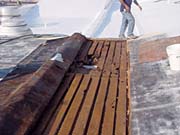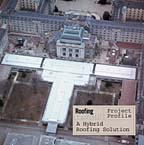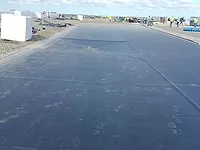Project Profile: A Hybrid Roofing Solution

Lake Industrial, a commercial/industrial roofing contractor, has been around since the 1980s. The company installs GE Silicone Roofing Systems as well as Carlisle, Sarnafil, Stevens, CertainTeed and others. General Manager Dave Markferding believes that Lake Industrial was chosen for the Naval Academy job because of the company’s attention to detail and success on previous projects “where conventional thinking did not provide the best available solution.”
Rice had determined that price was just as much of a concern to the Naval Academy as getting a watertight roof. He enlisted Lake Industrial to provide onsite inspections and evaluations to help determine the best course of action — one that would incorporate the best available technology with the most affordable approach. After Lake Industrial had completed a thorough site inspection, Rice suggested the use of a “hybrid” high-performance system that consisted of SPF, an industrial polyurea coating, and a white, solvent-based topcoat. The latter would ensure a “cool roof” solution as well.
The goal was for this roofing system to allow the Naval Academy to have a watertight roof for its cadets that could be maintained through periodic preventative maintenance for many years to come.

Repairing the Damage
The roof consisted of large barrel roofs with hundreds of feet of valleys that were covered by heavy, corrugated-steel grating, which served as walkways. The failed condition of the existing roof was extreme. The aged EPDM rubber roof seams were open, allowing water to enter through the original built-up roof.First on the agenda was to power wash the entire existing EPDM surface, followed by cleaning and priming with a specially formulated EPDM primer. Then the crew from Lake Industrial applied a fabric mesh tape to all the seams and recoated the seams with a solvent-based coating. The mesh tape allows the coating to permeate the farbic, acting as a coating adhesive to the EPDM surface. According to Markferding, this method is becoming a standard application technique in the coating of EPDM rubber roofs.
The next step was the coating process. The crew first applied the base coat to begin to build the specified thickness and to help stop some of the numerous leaks in the building. After the base coat was installed on the upper portions of the barrel roofs, the Lake Industrial team installed SPF in those valleys that did not have corrugated steel grating. The SPF was sloped to the drains to help eliminate water ponding in the valleys and transitional roof areas, which were flat and funneling water from one roofing plane to another. “This was a successful approach,” Markferding explains, “especially since using SPF on the entire roof was too costly for the Academy’s budget.”
At this point in the project, Lake Industrial began to remove the heavy steel corrugated grating, only to discover that the old roofing system in these valleys was extremely deteriorated and could not be saved. In these areas, tear-off was required. After removing the two types of roofing, Lake Industrial mechanically installed a layer of isocyanurate insulation board to serve as the receiving surface for the SPF roofing. After the SPF was installed, a base coat was applied to protect the SPF from ultraviolet degradation while the crew rebuilt the saturated valleys.
The next step was to apply the industrial polyurea coating onto all the steel supports that carried the corrugated steel grating. The polyurea coating was also installed over old copper flashing that had sprung open and was not performing as intended. When all of the valleys were finished, Lake Industrial applied two more coats of the solvent-based white coating and reinstalled the hundreds of feet of corrugated steel grating. The final detail was to apply urethane caulking and the open mesh fabric around all of the perimeters of the roofing surface.
The only problem that came up was that the new, cool, white roof was extremely bright. The Academy requested that the top surface be tinted a light “Navy Gray” to cut down on some of the glare affecting the surrounding dormitories and offices. This done, the job was pronounced a success. The Lake team performed the reroofing work as specified, even with the color coating change order 10 days ahead of the short construction permitted. Even though this was not a conventional approach, the company was able to adapt to overcome the obstacles inherent in the site and bring the project in both ahead of schedule and well within the limited budget restrictions.
Looking for a reprint of this article?
From high-res PDFs to custom plaques, order your copy today!




